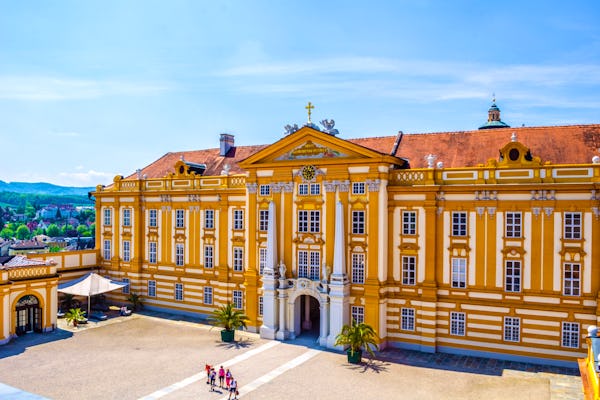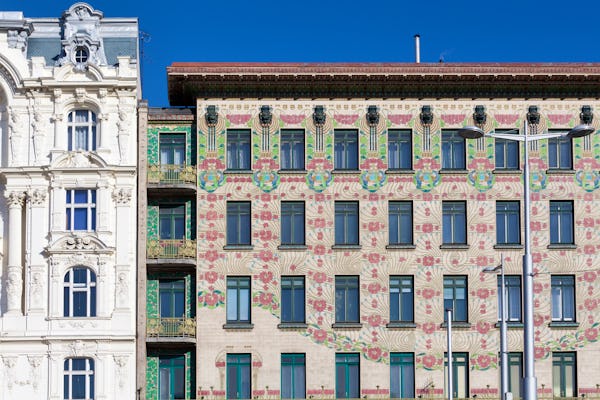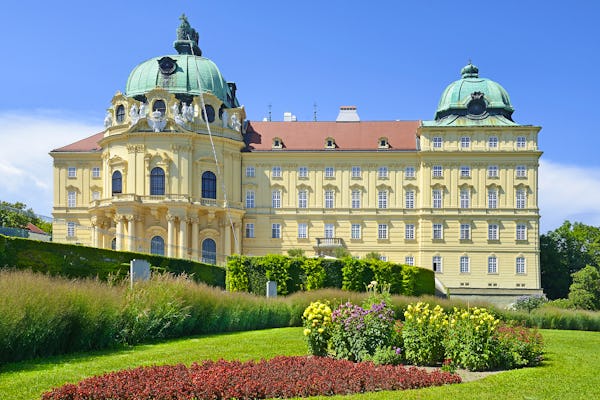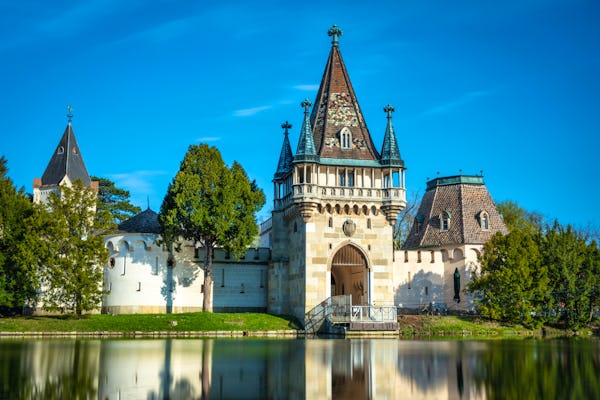Austria's Heartland: 1000 Years of Art and Culture
The historical and cultural heartbeat of Austria began to pulse 25,000 years ago in an area roughly located between Linz and Vienna, in the present-day states of Upper and Lower Austria. Its main artery, the river Danube, has carved out a picturesque landscape, from the narrow Wachau valley dominated by bountiful vineyards and orchards, to the wide Vienna basin where the forested highlands of the Vienna Woods are bounded by the Danube. After the fall of Roman power, the region was reorganised by the Carolingians who established a march, or borderland, at the eastern outpost of the Frankish Empire named the Marcha Orientalis or ‘Ostarrichi’ (Austria). The noble Babenberg family, enfeoffed with ‘Ostarrichi’ in 976, further cultivated the land through the foundation of well-endowed abbeys such as Heiligenkreuz and Klosterneuburg, where the seat of government was initially established. Later relocated to Vienna, Austria was elevated to the rank of an independent duchy in 1156. The Babenberg dukes of Austria fostered a Vienna that further flourished under successors from the House of Habsburg but before long, the expansion of the Ottoman Empire developed into a constant threat for all of Austria’s eastern lands. The Battle of Vienna in 1683 marked a turning point in the success of the Ottomans, who were forced to retreat, and a building boom rolled across Austria. Ancient abbeys like St Florian, Melk and Klosterneuburg, now in a deplorable state, were rebuilt in awe-inspiring Baroque dimensions and decoration. The dawn of the 19th century heralded a new artistic era: glorious historicist architecture, from the neo-Gothic Castle Franzensburg in Laxenburg, to the spectacular buildings of the Vienna Ringstrasse, shaped not just the capital but also neighbouring St. Pölten. At the turn of the 20th century, both cities began to temper this eclectic aesthetic with the new Art Nouveau style, becoming prominent proponents of the movement’s art and architecture.
Your Tour Includes
- Return economy flights from London Heathrow to Vienna
- 3 nights’ bed and breakfast at the Cityhotel Design & Classic
- 3 nights’ bed and breakfast at the Hotel Beethoven
- Private coach transfers and excursions in Austria
- Guided visits to sites listed in the programme
- Services of your expert lecturer and Tour Manager
- Detailed programme and study notes
Itinerary
Please choose your preferred 7 day itinerary
Morning flight with Austrian Airlines from London Heathrow to Vienna. Coach transfer from Vienna airport to the Cistercian abbey of Heiligenkreuz, peacefully situated in the Vienna Woods. Founded by the later canonised Babenberg margrave Leopold III in 1133, the abbey church and cloister retain a Romanesque and early Gothic appearance, including some fine stained-glass windows dated c.1295. From Heiligenkreuz we continue to St. Pölten, where we will check in to our four-star hotel for the first of three nights. In the evening, we enjoy a meal together.
Includes Dinner
After breakfast, we set out on foot to explore the cosy old town of St. Pölten. Originally founded by the Romans and resettled by the Franks, St. Pölten has a rich catalogue of archaeological finds, many of which are on display in the Stadtmuseum. St. Pölten’s contribution to the development of the Austrian Art Nouveau style is also charted here. Connections with the Vienna Secession led Joseph Maria Olbrich to work in St. Pölten and several local architects also studied with Otto Wagner in the city. It’s their buildings that – in addition to the Baroque architectural heritage – shaped the distinctive look of the city as we see it today. In the afternoon our exploration continues with a visit to the 18th-century cathedral and neighbouring diocesan museum. Partly housed in the delightful Rococo library of the former Episcopal Palace, the museum’s collection boasts liturgical vestments worked by Empress Maria Theresa herself and a display of religious art from the Middle Ages to the Baroque. The evening is free for independent activities.
Includes Breakfast
All-day coach excursion. Our first stop is the Baroque abbey of St Florian, dedicated to the first recognised Christian in Austria. Martyred in the 4th century, his burial site soon became a pilgrimage destination, and the first abbey was built here in c.800. In 1686 a rebuilding in the Baroque style began, first and foremost designed by the leading local architect of the age, Jakob Prandtauer of St. Pölten. We will immerse ourselves in the artistic delights on offer: a fabulous collection of Danube School paintings by Albrecht Altdorfer, who created two altarpieces for St. Florian, a frescoed Baroque library and festive marble hall, and the handsome imperial apartments. The abbey also has a rich musical tradition with close ties to the composer Anton Bruckner, who worked as an organist in St. Florian; in accordance with his last will he was buried underneath his beloved organ in the crypt of the abbey church. We pay homage to the great composer by his grave and enjoy an organ recital of his music in the delightfully stuccoed and frescoed abbey church. The day is concluded with a visit to the country church of Mauer bei Melk, which houses a stunning, expressively carved wooden altarpiece considered one of the best sculptural examples of the Danube School. Return to St. Pölten for a group meal and our third and final night in the city.
Includes Breakfast
Includes Dinner
In the morning, we bid farewell to St. Pölten and head north into the beautiful Wachau valley. Soon Melk abbey, impressively perched on an outcrop above the river, comes into sight. We spend the morning roaming this vast abbey complex with its museum and yet another splendid Baroque library and marble hall. The abbey church, the opus magnum of Jakob Prandtauer, allows a comparison with architectural principles first introduced in St Florian. After the visit, we continue to wind our way along the Danube, passing through charming wine villages. A group lunch in one such village will offer the chance to sample the culinary delights of the region and its famous wines, made from the Grüner Veltliner grape. From here we head for Vienna, our base for the next three nights of the tour.
Includes Breakfast
Includes Lunch
The morning is dedicated to the work of Otto Wagner, master architect of the Art Nouveau style. We take the coach to Hütteldorf, a Vienna suburb where Wagner built himself two private neighbouring homes, conveniently allowing us to study his artistic development. The first building, a proponent of late Historicism is decorated with Tiffany-style-stained glass windows by Adolf Böhm and mosaics by Koloman Moser. The successor next door, today in private ownership and only viewable from the outside, is, in its architecture and decor, a model example of the Vienna Secession style. Nearby is Wagner’s Kirche am Steinhof, one of the most important Art Nouveau churches ever built. Spectacularly perched atop a hill, it has been meticulously restored with gleaming contemporary furnishings. In the afternoon, we return to the city centre for an afternoon to spend as you wish. From relaxing with an irresistible slice of traditional Sachertorte, to exploring one of Vienna’s many fabulous museums, there are plenty of activities to enjoy.
Includes Breakfast
After breakfast we travel by coach to Klosterneuburg, on the northern outskirts of Vienna. Founded in 1114 by Margrave Leopold III and his wife at the site of a purported miracle, the abbey has been one of Austria’s most important centres of art and culture for more than 900 years. Much like the abbeys of St Florian and Melk, the whole complex was given a Baroque facelift which is best studied in the spectacular abbey church. However, wonderful mediaeval treasures to survive include the cloister, a magnificent seven-armed bronze candelabrum, and the famous 12th-century ‘Verdun Altar’, Nikolaus von Verdun’s breath-taking enamel altarpiece. The abbey was also a residence of the Babenberg and Habsburg dynasties and an outstanding document of the Babenberg dynasty in the abbey’s art gallery is a four by eight metre large family tree, painted in the late 15th century. The treasury houses beautiful liturgical objects including a rare Art Nouveau clerical vestment linked with Otto Wagner’s Kirche am Steinhof. On the culinary front, Klosterneuburg also offers much to delight. Home to the Austrian state winery, exquisite wines produced on the estate are on offer in the cafés and restaurants on the abbey grounds. Return to Vienna for a farewell dinner.
Includes Breakfast
Includes Dinner
As a final visit we travel out of Vienna to Laxenburg, where large hunting grounds and various smaller palaces were used by Habsburg monarchs as a summer retreat. A large portion of these grounds were transformed into a romantic English landscape garden with a great lake dotted with islands at its centre. On one of these islands, an enchanting neo-Gothic castle, Franzensburg, was erected by Emperor Francis II/I, hence its name. We walk (or take a little train) through the shady expanses of the park to reach the small ferry that takes visitors to the island. The furnishings of Franzensburg were gathered from historic castles, palaces, and churches all over lower Austria, including Klostneuburg and Melk, and the castle is a cornucopia of first-class Austrian art from the Middle Ages to early Baroque. After lunch, our coach takes us on to nearby Vienna airport for a flight with Austrian Airlines to London Heathrow.
Includes Breakfast
Includes Lunch







